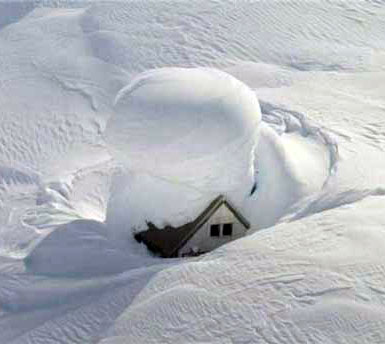This article comes full circle to end where it began, with universal design. When designing for the full spectrum of life, universal design is most easily and inexpensively accomplished at the onset, not mid-way or as a retrofit. When building or modifying a home, one can do much to make the challenges of winter simpler and more manageable. Use the following list to help guide your designs at the planning stages of construction.
New Home Construction
• As a general guideline, make your home as maintenance-free as possible. When faced with material choices, ask yourself not just which one you like but also which one will require more upkeep.
• Entrances are covered with an overhang or awnings. This protection not only keeps snow and ice off the areas you use first when stepping outside, they are good for rain too.
• Make sure your roof sheds snow and that the snow doesn’t fall into a walkway, block an entrance or destroy landscaping.
• Minimizes ice build up along roof edges with a ventilated roof design that dissipates heat which would melt snow and form ice.
• Like Goldilocks, build a roof pitch that’s just right: a steep, slippery roof and snow slides off real fast causing a mini-avalanche; a flat roof has to support the weight of snow build-up and not leak; just right is a medium pitch and textured roof, it holds the snow and is sheds water.
• Larger overhangs keep snow and water away from your foundation.
• Gutters are often a cause for much debate; I suggest that you ship the gutters and look at other solutions.
• Mailboxes get damaged from snow slammed into it by plows: build it really solid, or allow it to swing.
• Take advantage in winter of the warming sun (passive solar heat gain); have entrances and primary walkways face south (really helpful if garage door faces south).
• Have an outlet in the garage near the engine; some engines can be preheated for easier starting. You can also slightly heat the garage.
• When possible, have a drain in the garage with the floor slightly pitched to it. This will allow snow melting off the car to drain.
• Heated exterior walkways and steps (anti-icing); why shovel snow when you can flip a switch. These are more cost-effective for high traffic areas or when other means of snow removal are not possible.
• Design drainage away from the building.
• Pitch walkways and driveways to drain water – no puddles that turn to ice! This can be achieved by having a slight elevation.
• Bury your water pipes deep enough, especially those that enter or exit the building. Avoid having pipes placed in exterior walls as they are more prone to freezing (and bursting).
• Choose road and walkway surfaces that are easy to plow or snow blow; these are smooth but gritty.
• Choose a home on a primary street; it will be among first to be plowed – tiny, dead ends and side roads get plowed last.
• Railings: everywhere and as much as possible.
• If you have exterior stairs, cover them (ideally don’t have stairs). Have open risers which allow snow to be pushed out rather than shoveled up and over the railing.
• Ramps with less grade 1:16 will work in snow better than steep grades, A 1:10 grade becomes inaccessible with even a little snow on it. Remember to pitch ramps so they easily drain water off their surface.
• Use appropriate materials for winter weather, ones that require low maintenance and afford suitable protection (don’t build a Carribbean style home in Alaska).
• Do not place an entrance under a roof that is likely to shed snow.
• Consider prevailing winds and anticipate snow drifts; keep entrances and walkways out of the wind.
• Design walkways and driveways so that a plow or snow blower can push or blow the snow to where it will be out of the way. For example, have the garage door not at the end of the driveway but along its side; this way the plow can push the snow past the garage door minimizing the work you have to do to keep the garage clear of snow.
• No steep walkways or driveways – 10% grade max; more that that makes a slippery condition really treacherous.
• Design an entrance vestibule / boot room / mud room, a place for coats, boots and a place to change leaving behind wet items. Have a textured floor surface and ideally a drain. A vestibule also baffles the cold from entering the rest of the home. If a vestibule is not possible, have thin grippy throw rugs near entrances to keep floors dry and not slippery.
• Have back-up power such as a generator.
• Lighting: have plenty of automated lighting for walkways, stairs, entrances, garages and the building exterior. Avoid walking in the dark especially if there might be ice.
• Check with your town/municipal laws about sidewalk & parking lot snow clean-up; you might be responsible for the sidewalk in front of your home.
• If you like to grill, design a spot for the grill that is accessible and protected from the elements – make sure there’s no fire risk!
There are more considerations which vary according to personal need and the building location. When initiating work with a builder, interview them and test their skills when it comes to building in snow country, you would be surprised how many builders relocated into regions where their past building experience isn’t adequate.

